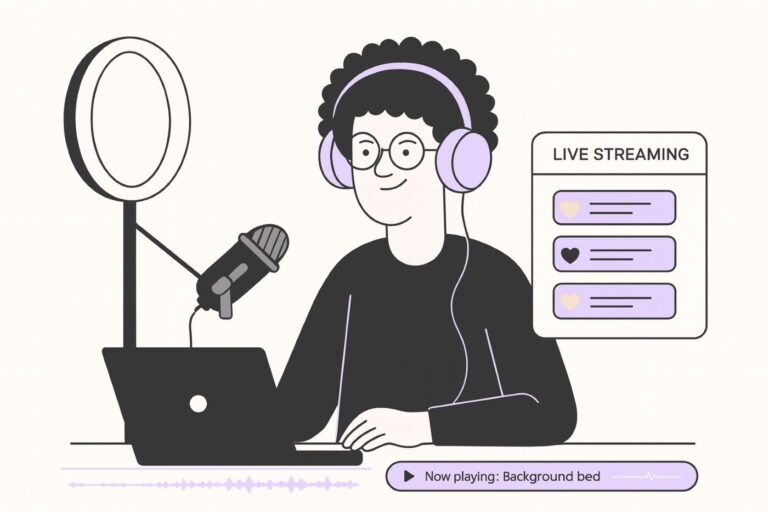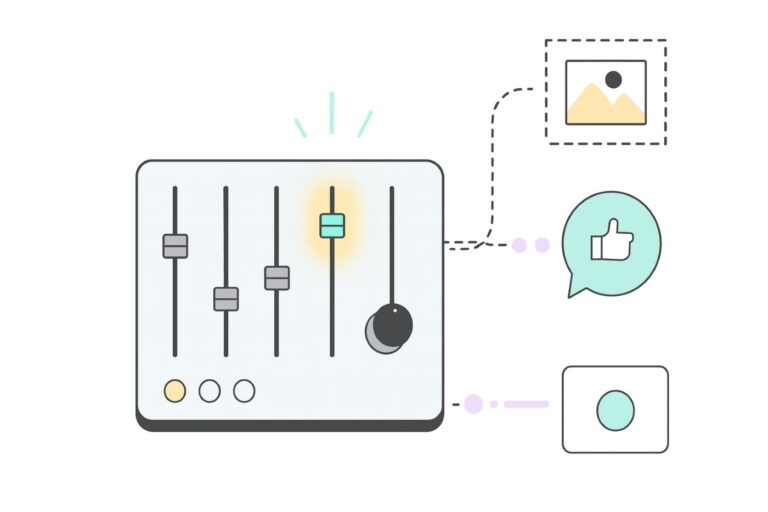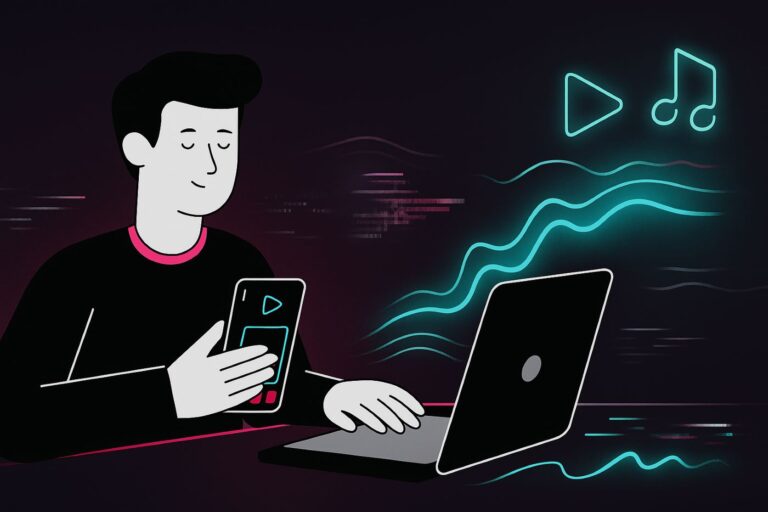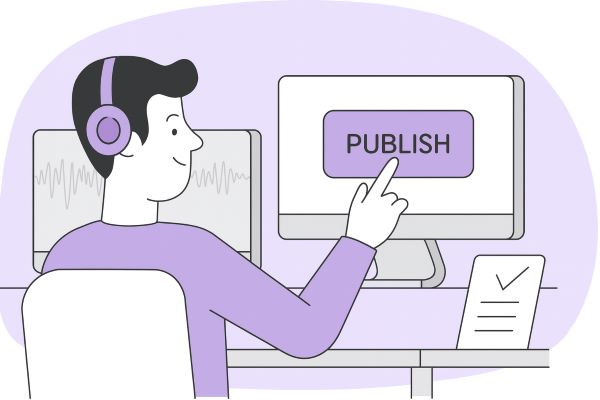Everything You Need to Know About Royalty-Free Music Licensing
Audiodrome is a royalty-free music platform designed specifically for content creators who need affordable, high-quality background music for videos, podcasts, social media, and commercial projects. Unlike subscription-only services, Audiodrome offers both free tracks and simple one-time licensing with full commercial rights, including DMCA-safe use on YouTube, Instagram, and TikTok. All music is original, professionally produced, and PRO-free, ensuring zero copyright claims. It’s ideal for YouTubers, freelancers, marketers, and anyone looking for budget-friendly audio that’s safe to monetize.
Stock tracks are a USD 1.21 billion industry sprinting toward USD 2.82 billion by 2031, growing nearly 10 percent each year.
Driving that surge is royalty-free music. Itself expanding at 9.7 percent: pay once, use forever, no hidden fees – exactly what cash-strapped creators and brands need when deadlines, channels, and views multiply.
Defining “Royalty-Free”
Royalty-free licensing flips the old model on its head. Instead of tracking every view or sale, you clear the track once, then focus on the project itself. That certainty keeps budgets tight and approval cycles short.
For example, if you buy a royalty-free track for a YouTube video, you will not owe extra fees each time someone hits “play.” This helps content creators stay within a budget. It also reduces the hassle of monthly or yearly royalties.
The licence, however, is not a blank cheque. It spells out media channels, audience size, and any geographic limits. A YouTube-only plan may block broadcast TV, while some indie libraries bar theatrical releases to protect film-festival deals.
Key Points to Keep Straight
Royalty-free never means copyright-free. The composer and label still own the track; your payment simply buys a wide permission slip. You can mix, export, and publish without begging for each play.
Read the fine print before you hit upload. Many licences allow web and social but stop at broadcast, cinema, or over one million impressions. If you cross that line, claims, muting, or renegotiation can follow fast.
Your one-off fee doesn’t kill the royalty stream; it shifts it. The library funnels its share to writers and publishers through blanket deals or waived claims, so you avoid extra invoices, yet creators still earn.
This model started in the 1990s with stock photos that moved from pay-per-use to credit packs. Music libraries copied the playbook, swapping slow negotiations for click-to-license convenience that now powers reels, ads, and podcasts.
Where Creators Still Trip Up
Royalty-free covers sync, not playback. When your ad airs on TV, the station must still file cue sheets and pay ASCAP or BMI for public performance. Those fees land on the broadcaster but can stall clearance checks.

Using the track as a ringtone, soundtrack album, or in-app download counts as reproduction or resale, so a basic royalty-free licence won’t cover it. Secure a mechanical or master add-on from the publisher or label.
Even compliant tracks trip YouTube’s alarms if metadata mismatches. Upload the licence ID in your video description and verify the library has allowlisted your channel. If a claim still appears, dispute it swiftly with the certificate to restore monetisation.

The Three Main Licensing Models
Every track you add to a project sits under a licence that decides how much you pay and what you can do with the music. Royalty-Free, Rights-Managed, and Creative Commons are the three models you’ll meet most often. Each works differently, from upfront cost to legal reach.
Royalty-Free Licensing
Budget-minded creators lean on royalty-free tracks because the price never climbs with reach. One licence can cover ten plays or ten million without another invoice, making it ideal for content that lives online forever.
Rights-Managed Licensing
Rights-Managed pricing changes with every project. A short regional web ad might cost a few dollars, while a worldwide cinema campaign could run thousands. Fees rise or fall with audience size, territory, and run time, giving rights-holders fine-grained control and higher revenue per use. If the campaign expands, you renegotiate or pay a top-up, so tracking each licence term is crucial.

Creative Commons Licensing
Creative Commons offers preset licences that creators can apply for free. Some versions only ask for attribution, others block commercial use, and a few require you to share edits under the same terms. No money changes hands, but the rules are strict: miss the credit line or sell a CC-BY-NC track in a paid app, and you breach copyright. Always check the exact CC symbol before publishing.

How the Three Main Licence Models Compare
Royalty-free, rights-managed, and Creative Commons all clear music, but they charge and restrict you very differently. The quick grid below shows the payment style, usage ceiling, and the projects each model really fits.
| License Type | Payment Structure | Usage Limits | Typical Use Cases |
|---|---|---|---|
| Royalty-Free | One-time fee, no ongoing royalties | Usually broad usage, but may exclude high-budget commercials | YouTube videos, podcasts, small/medium business projects |
| Rights-Managed | Cost varies by usage (time, region, audience size) | Specific to each project – renew or pay more if the scope expands | High-profile ads, feature films, and large-scale campaigns |
| Creative Commons | Often free to use, but some licenses require attribution | Varies by CC license (e.g., Non-Commercial, ShareAlike, etc.) | Non-profit, hobby projects, or creators who don’t mind attributing the artist |
Why Choose Royalty-Free Music?
Royalty-free music keeps budgets lean, speeds production, and shields content from claims, making it the default soundtrack for modern creators and brands.
Cost-Effectiveness
Traditional licensing charges per use and wrecks the budget. With royalty-free, a single fee or subscription covers every edit on the docket, letting teams spend on cameras and crew instead of paperwork.
A freelancer can buy one track and reuse it across a video series without extra invoices, while a small agency can sign an annual plan that fuels dozens of client spots at no additional cost.






Because the price stays flat as views climb, marketers feel free to boost posts or extend campaigns when content outperforms expectations, confident that no hidden royalties will surface later.
Simplified Licensing Process
Clearing music once beats, juggling separate sync, performance, and mechanical permissions. Royalty-free libraries pre-clear those layers, folding them into a short, plain-language agreement.
Many sites show all key terms on one screen – media, territory, and term. You download the PDF, drop it in the project folder, and move straight to color-grading.
By removing lawyers and waiting periods, production timelines shrink; agencies can pitch with temp tracks on Friday and deliver final cuts on Monday without legal roadblocks.
Flexibility
Modern brands publish on YouTube, TikTok, podcasts, trade shows, and in-store loops. Royalty-free coverage spans these outlets, keeping a consistent sonic logo everywhere the audience listens.
Libraries often supply alternate mixes, stems, and loops, so editors adapt the same motif to trailers, shorts, and long-form tutorials while staying perfectly on brand.

When a campaign pivots, you change platforms or formats without renegotiation, letting creative teams test trends quickly and meet real-time marketing moments.
Legal Compliance
Copyright lawsuits burn cash and credibility. Royalty-free vendors secure all composer, performer, and publisher rights first, then hand you a dated license certificate as proof.

If Content ID flags the upload, send the certificate and the claim drops, protecting monetisation and keeping the video live. Staying inside the licence guardrails means no takedowns, no frantic re-edits, and no client panic when launch day arrives.
Wide Selection of Music
Royalty-free catalogues now rival label rosters, covering pop, jazz, orchestral, and experimental genres, with fresh tracks added weekly to capture cultural shifts and seasonal moods.
Sophisticated search filters sort by BPM, key, length, or even sonic similarity, turning crate-digging into a ten-second task. Access to vast libraries lets indie creators match studio-level polish without hiring composers or chasing expensive master clearances.

Global Use
The internet ignores borders, and so do many royalty-free plans, granting worldwide rights for the life of the project – ideal for apps, MOOCs, and global ad campaigns. Launch in English today, localise into Spanish tomorrow, and the same certificate still covers the soundtrack, smoothing every international rollout.
Some niches, like Japanese broadcast TV or French theatrical release, may require an upgrade; checking territorial exclusions early saves costly last-minute music swaps.
Personal & Commercial Use
Royalty-free music can cover both personal and commercial projects. Yet the terms can vary. If you are just making a family slideshow with no plans to earn money, a standard royalty-free license might suffice. But if you are creating a sponsored video or selling a product, you must check if the license is valid for commercial use.
Personal Use
Personal projects live outside profit cycles. A school video, family slideshow, or hobby reel sits in this category because no money changes hands.
Most royalty-free libraries grant unlimited personal use after a single payment, letting you remix, trim, and repost the track as often as you want. If the video later earns ad revenue, that use flips to commercial, and you’ll need to upgrade before the channel starts serving ads.
Commercial Use
Commercial projects aim to bring in money, whether through sponsorships, product sales, or paid client work, so the licence must cover revenue-generating activity.
Many stock sites split their plans into personal and commercial tiers, with commercial licences adding broadcast, advertising, and unlimited impressions across multiple channels.

Brand Usage and Monetization
A brand that relies on a signature sonic style needs consistency across videos, podcasts, ads, and live events, so the licence must cover every outlet the audience touches.
Enterprise music plans often grant blanket rights inside one organisation, allowing unlimited seats, platforms, and territories after a single annual or lifetime payment.

Before signing, confirm monetisation specifics like YouTube allowlisting, podcast ad inventory, and paid social boosts to avoid hidden fees or channel strikes later.
Quick Decision Guide: Do You Need a Personal or Commercial License?
Answer three quick questions to learn if your project needs a commercial music license or if personal-use coverage is enough, even on broadcast.
Do I Need a Commercial Music License?
Perpetual vs. Renewal
Not all royalty-free licenses last forever. Some are perpetual, meaning once you pay, you can use the track forever under the agreed terms. Others might expire or ask for renewal after a certain time.
Perpetual Licenses
These are often the simplest. You make one payment and get ongoing rights to use the music as stated. This is great for long-term campaigns or content that stays online for years. You will not need to worry about re-licensing later. However, it is important to keep a record of your license in case you need to show proof.
Renewal-Based Licenses
Some providers offer monthly or yearly subscriptions. As long as you keep your subscription active, you can use any track from their library. But once you stop, you might lose certain rights for future projects.
You may still keep the rights for the content you created while you subscribed, but you cannot create new content with those tracks. Each library has its own rules. Some might let you continue using the music in already-published content, while others require you to remove it.
Limitations in Use
Royalty-free music still carries guardrails because you’re licensing a copyright, not buying it outright. Libraries keep these limits in place to protect the artists’ work, prevent resale abuse, and ensure the pricing stays fair for everyday creators. Some of the most common limitations include:
No standalone distribution – tracks must sit under video, podcast, game, or app content rather than appear as music-only uploads, playlists, ringtones, or sample packs.
No resale or sub-licensing – you can’t hand raw files to clients or register the music with Content ID and claim it as your own.
Single-seat access – one account equals one user; sharing log-ins risks fees or suspension unless extra seats are purchased.
Platform and territory walls – creator tiers usually cover personal web and social use only; broadcast, theatrical, or multi-territory ads need an upgraded plan.

No paid-media ads or corporate promos – entry-level licences forbid pre-rolls, boosted posts, and brand spots without a dedicated advertising tier.
No illegal, hateful, or adult content – pairing music with violence, discrimination, pornography, or political endorsements breaks the licence.
Editing limits – trimming, looping, and fading are fine; remixing stems into a new song or altering melody or lyrics is not.
No trademarks, logos, or theme songs – using the track as a sonic logo or brand anthem requires a custom deal.
No NFTs, AI training, or blockchain uses – most libraries ban minting tracks as tokens or feeding them into generative models.
Cue-sheet and PRO caveats – broadcasters may still need to file cue sheets and pay performance royalties even after you buy the track.
Use the checker below – select how you’ll use the track and instantly see whether you’re green-lit, need an upgrade, or must stop.
Licence Limitation Checker
Actionable Tips
These simple checks keep your soundtrack legal, your budget intact, and your uploads online. Run through them before you publish so you never scramble over last-minute licence surprises.
Check License Length
See if the license is perpetual or requires annual renewals. If you have a long-running campaign, you might prefer a license that does not expire.
Understand Personal vs. Commercial Distinctions
If your content brings in money, you need a commercial license. Do not assume a free or basic plan will cover your paid campaign. Double-check the details.
Review Platform Permissions
Make sure your chosen license supports your release channels. That might include YouTube, Spotify (for podcasts), or broadcast TV. If the license does not mention a platform, ask the provider for clarity.
Keep Records
Organize proof of your purchase. Store receipts, license documents, or email confirmations in a folder. If you face a copyright claim or a platform’s Content ID match, you can respond fast with evidence.

Look for Reputable Libraries
Seek royalty-free providers with clear explanations of their licenses. Artlist, Epidemic Sound, AudioJungle, and Pond5 are popular choices. They often list usage tiers like “personal,” “commercial,” or “enterprise.” Choose the tier that fits your scope.
Read Renewal Terms Before Subscribing
Subscription-based libraries can be a bargain if you release a lot of content. But remember that once you cancel, you might lose the right to new uses. Decide if you plan to produce content beyond the subscription period.
Real-World Case
When Royalty-Free Might Not Be Ideal
Royalty-free music has many perks, but it is not perfect for every project.
Lack of Well-Known Tracks: You rarely find chart-topping hits in royalty-free libraries. If your campaign depends on a famous song to connect with your audience, you will likely need a traditional license.
Specific Use Cases: Some library licenses limit high-budget commercials or broadcast TV. If you need to show your ad on major TV networks or big film festivals, you might need to negotiate a custom license.
If your brand strategy relies on recognizable music or if you need advanced usage rights, royalty-free might not be the best path. In those cases, you may have to speak directly with major labels or independent artists.
Choosing the Right Royalty-Free Music Provider
Picking the right library can make or break your audio experience. Look for sites that:
- Offer Clear Licensing Terms: The rules should be simple to read. You should know exactly what you can and cannot do with the track.
- Have Diverse, High-Quality Music: The best libraries sort their tracks by style, mood, or theme. They also provide previews so you can test the music before buying.
- Support Commercial and Public Performance Needs: Not all libraries allow you to use tracks in ads or large-scale events. Check if the library mentions these uses in its commercial license.
Examples include Artlist, Epidemic Sound, AudioJungle, and Pond5. Each has a different pricing model and selection. Some let you download unlimited tracks under a subscription. Others charge per track. Compare these options based on how much content you plan to release, your budget, and the type of audience you aim to reach.

Audiodrome was created by professionals with deep roots in video marketing, product launches, and music production. After years of dealing with confusing licenses, inconsistent music quality, and copyright issues, we set out to build a platform that creators could actually trust.
Every piece of content we publish is based on real-world experience, industry insights, and a commitment to helping creators make smart, confident decisions about music licensing.















